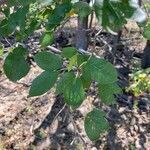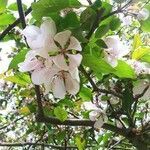Trees, sometimes shrubs, 25–75(–100) dm. Stems 1–45 cm diam.; bark reddish brown to gray, longitudinally fissured with platelike scales; young branches reddish brown to dark brown, with orange lenticels, pubescent, glabrescent; flowering shoots becoming spurs or spiny thorns, (10–)20–40(–100) mm. Buds reddish brown, ovoid, 1–6 mm, scale margins tomentose. Leaves conduplicate in bud; heteromorphic; stipules deciduous, linear-lanceolate, (3–)4–6(–7) mm, apex acuminate; vigorous shoot leaves: petiole (7–)10–25(–30) mm, glabrous or villous, sometimes puberulent; blade ovate or triangular-ovate, sometimes lanceolate, (2.5–)4–8(–10) × (1.5–)4–6(–8) cm, base rounded or cordate-rounded, sometimes cuneate, margins ± lobed, sometimes unlobed, serrate, sometimes doubly serrate or crenate-serrate, apex broadly acute or acute, sometimes rounded, apiculate, abaxial surface glabrous (villous only on veins), adaxial glabrous; flowering shoot leaves: petiole 5–15(–25) mm, glabrous or villous; blade ovate, triangular-ovate, or lanceolate, sometimes oval or elliptic, (15–)20–60(–85) × (10–)15–45(–60) mm, base rounded or cordate, sometimes cuneate-rounded or cuneate, margins lobed or unlobed, serrate, sometimes crenate-serrate, doubly serrate, or entire, apex acute or broadly acute (rounded with point or rounded), abaxial surface glabrous (veins villous), adaxial glabrous. Panicles corymblike; peduncles absent; bracteoles sometimes persistent, filiform, 3–5(–10) mm. Pedicels (10–)20–30(–40) mm, glabrous, sometimes villous. Flowers 25–40 mm diam.; hypanthium glabrous, sometimes puberulent; sepals triangular, (3–)4–6(–7) mm, equal to slightly longer than tube, apex acute or acuminate, abaxial surface glabrous, sometimes glabrescent, adaxial hoary-tomentose; petals pink, sometimes fading white, oblong-obovate, ovate, or oblong, (11–)12–18(–20) mm, claws (2–)3–4 mm, margins entire, sinuate, or fimbriate, apex rounded; stamens 20, (8–)10–13(–14) mm, anthers pink, rose, salmon, or purple before dehiscence; styles 5, connate basally, (8–)10–12(–16) mm, equal to or slightly longer than stamens, villous in proximal 1/2. Pomes green or yellow-green, depressed-globose, 15–30(–55) mm diam., cores not enclosed at apex; sepals persistent, erect; sclereids abundant surrounding core. Seeds dark brown. 2n = 34, 51, 68.
More
A very small deciduous tree. It grows up to 9 m high. The trunk is 30 cm across. The crown is irregular and spreading. The bark is red-brown and scaly. It develops cracks along it. The leaves are long triangle shaped. They are 3-10 cm long by 6 cm wide. The base is rounded or heart shaped. The teeth increase in size from the tip downwards and can become lobes near the base. The flowers are white streaked with pink. They occur in small clusters of 2-3. The fruit are almost round and 25-35 mm across. They are sour.
Can be grown by cuttings or seedlings. Seeds needs stratification.





